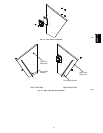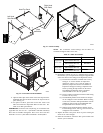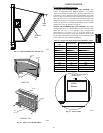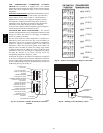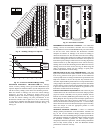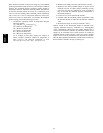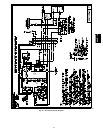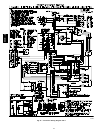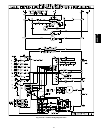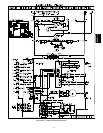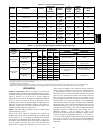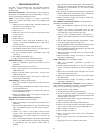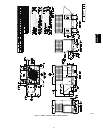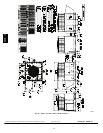
48
DAMPER MOVEMENT — Damper movement fromfull open to
full closed (or vice versa) takes 2 1/2 minutes.
THERMOSTATS — TheEconomizer controlworks with conven-
tionalthermostatsthathaveaY1(coolstage1),Y2(coolstage2),W1
(heatstage1),W2(heatstage2),andG(fan).TheEconomizercontrol
doesnotsupportspacetemperaturesensors.Connectionsaremadeat
thethermostatterminalconnection boardlocated inthemain control
box.
OCCUPANCY CONTROL — The f actory default configuration
for the Economizer control is occupied mode. Occupied status is
providedby theblackjumperfromterminalTR toterminalN.When
unoccupied mode is desired, install a field supplied time clock
functioninplaceofthejumperbetweenTRandN.SeeFig.44.When
thetime clock contacts areclosed, the Economizer controlwill be in
occupiedmode.Whenthetimeclockcontactsareopen(removingthe
24-- v signalfromterminalN),theEconomizer willbeinunoccupied
mode.
DEMAND CONTROLLED VENTILATION (DCV)—When
using the Economizer for demand controlled ventilation, there are
someequipmentselectioncriteriawhichshouldbeconsidered.When
selecting the heat capacity and cool capacity of the equipment, the
maximum ventilation rate must be e valuated for design c onditions.
The maximum damper position must be calculated to provide the
desiredfreshair.Typicallythemaximumventilation r atewillbeabout
5 to 10% more than the typical CFM required per person, using
normal outside air design criteria. An exponential anticipatory
strategy should be taken with the following conditions: a zone with
alargearea,varied occupancy,andequipmentthatcannot exceed the
required ventilationrate a tdesign conditions.Exceeding therequired
ventilation ratemeans t heequipment cancondition airatamaximum
ventilation rate that is greater than the required ventilation rate for
maximum occupancy. An exponential--anticipatory strategy will
causethefreshairsuppliedtoincreaseastheroomCO
2
levelincreases
even though the CO
2
set point has not been reached. By the time the
CO
2
level reaches the set point, the damper will be at maximum
ventilationandshouldmaintainthesetpoint.InordertohavetheCO
2
sensorcontroltheeconomizerdamperin thismanner, firstdetermine
the damper voltage output for minimum or base ventilation. Base
ventilation isthe ventilation required toremove contaminantsduring
unoccupied periods. The following equation may be used to
determinethepercentofoutside-- airenteringthebuildingforagiven
damper position. For best results there should be at least a 10_F
(12.2_C) difference in outside and return--air temperatures.
(T
o
x OA/100)+ (T
R
x RA/100) =T
M
T
O
= Outdoor-- Air Temperature
OA = Percent of Outdoor Air
T
R
= Return--Air Temperature
RA = Percent of Return Air
T
M
= Mixed--Air Temperature
Once baseventilation hasbeen determined, setthe minimumdamper
positionpotentiometertothe correctposition. Thesame equation can
be used todetermine t heoccupied ormaximum ventilation r atetothe
building.Forexample,anoutputof3.6voltstotheactuatorprovides
a base ventilation rate of 5% and an output of 6.7 volts provides the
maximum ventilation rateof 20% (or baseplus 15 CFM perperson).
UseFig.42 to determinethemaximum settingoftheCO
2
sensor.For
example,a1100ppmsetpointrelatestoa15CFMperpersondesign.
Use the 1100 ppm curve on Fig. 42 to find the point when the CO
2
sensor output will be 6.7 volts. Line up the point on the graph with
the left side of the chart to determine that the range configuration for
the CO
2
sensorshouldbe1800 ppm.TheEconomizercontrollerwill
outputthe6.7voltsfromtheCO
2
sensortotheactuatorwhentheCO
2
concentration in the space is at 1100 ppm.
The DCV set point may be left at 2 volts since the CO
2
sensor
voltage will be ignored by the Economizer controller until it rises
above the 3.6 volt setting of the minimum position potentiometer.
Once the fully occupied damper position has been determined, set
the maximum damper demand control ventilation potentiometer to
this position. Do not set to the maximum position as this can result
in over ventilation to the space and potential high--humidity levels.
CO
2
SENSOR CONFIGURATION— The CO
2
sensorhaspreset
standard voltagesettingsthat canbe selectedanytime after thesensor
is powered up. Use setting 1 or 2 for equipment. See Table 16.
1. Press Clear and Mode buttons. Hold at least 5 seconds until
the sensor enters the Edit mode.
2. Press Mode twice. The STDSET Menu will appear.
3. Use the Up/Down button to select the preset number. See
Table 16.
4. Press Enter to lock in the selection.
5. Press Mode to exit and resume normal operation.
The custom settings of the CO
2
sensor can be changed anytime
after the sensor is energized. Follow the steps below to change the
nonstandard settings:
1. Press Clear and Mode buttons. Hold at least 5 seconds until
the sensor enters the Edit mode.
2. Press Mode twice. The STDSET Menu will appear.
3. Use the Up/Down button to toggle to the NONSTD menu
and press Enter .
4. Use the Up/Down button to toggle through each of the nine
variables, starting with Altitude, until the desired setting is
reached.
5. Press Mode to move through the variables.
6. Press Enter to lock in the selection, then press Mode to
continue to the next variable.
DEHUMIDIFICATION OF FRESH AIR WITH DCV
CONTROL—Information from ASHRAE indicates that thelargest
humidity load on any zone is the fresh air introduced. For some
applications, an energy recovery unit can be added to reduce the
moisturecontentofthefreshairbeingbroughtintothebuildingwhen
the enthalpy is high. In most cases, the normal heating and cooling
processes are more than adequate to remove the humidity loads for
most commercial applications.
If normal rooftop heating and cooling operation is not adequate for
the outdoor humidity level, an energy recovery unit and/or a
dehumidification option should be considered.
604D-- --A



